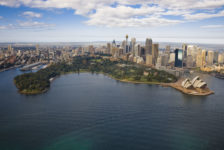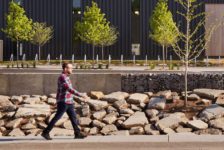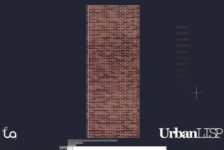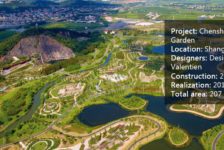17-August-15 The Latest News in Landscape Architecture 2015 is sponsored by ZinCo – Life on Green Roofs – Ecological and Economical Green Roofs, worldwide. In this week’s Latest News in Landscape Architecture we showcase school gardens in Texas to a proposed memorial garden in Japan that pays tribute to victims of the Sendai Tsunami. In addition, we feature Shanghai’s largest park complete with a thrilling comic book-like narrative and provide an update on New York’s The Lowline. Did you know that the proposed subterranean park raised a staggering $223,506 via Kickstarter? This feat makes it the most funded Public Art project on Kickstarter to date! 6 Stories In The News This Week:
- “Gardens Are About Imagination and Art and…Creating A Sense of Unity”
- Sasaki Associates Designs Shanghai’s Largest Park
- Beomki Lee’s Tribute to Victims of the Sendai Tsunami in Japan
- Q&A: Jan Gehl on Making Cities Healthier and the Real Meaning of Architecture
- Jaeyual Lee on Combining Ancient Elements of the Past with Technologies of the Future to Create the Lowline
- The Blossoming Health Benefits of School Gardens
(Click the headline for the full story)
Latest News in Landscape Architecture 2015
- “Gardens Are About Imagination and Art and…Creating A Sense of Unity”: The Sydney Morning Herald
Next month, designers from across the globe will travel to Melbourne for the Australian Landscape Conference 2015. Convener Warwick Forge wants to excite people’s imagination and contends that today’s projects have lost their edge. “I think an argument could be put that much of our landscape design is banal and predictable.” Regardless, the five-day event titled Art and Nature: Conflict and Harmony will run from September 18-22, 2015 and feature speakers, garden tours, workshops, and a series of social outings.
- Sasaki Associates Designs Shanghai’s Largest Park: World Landscape Architecture
Due to Shanghai’s rapid urbanization, it’s lost a significant amount of tree canopy coverage. (Shanghai metro area is only at 10% and China’s average is 25% for all cities) In response, the city announced plans for eight “green wedges” with the first aimed at becoming Shanghai’s largest park! Known as Zhangjiabang, the parkland will consist of 215 hectares of mixed forests, 46 hectares of shallow emergent wetland habitats, 113 hectares of open water, 12 hectares of community gardens, and much more. Sasaki’s principal in charge of the project, Michael Grove, has high hopes. “Zhangjiabang will be an immersive environment that prioritizes restoring native habitats and biodiversity in the region,” and that visitors to the park will be encouraged to “explore, discover, and understand the importance of reintroducing wilderness into the city.” Related Article: Shanghai Red Carpet Park Lets People Reflect on Their Everyday Lives WATCH: Shanghai’s Zhangjiabang Park
In March 2011, the Tōhoku earthquake and tsunami killed more than 10,000 people in Sendai, Japan. To commemorate the victims, MIT graduate, Beomki Lee has created an intriguing proposal centered around air, earth, and water. His approach treats the area as a series of memory sites, while using the foundations of destroyed building as locations for memorials. “The project seeks to challenge and extend traditional architectural definitions of memorial architecture,“ said Lee. “Each individual will have personalised experiences in each [ME]morial. [ME]morial will serve as a space not only for soothing victims’ wounded hearts, but also for letting people memorialise their individual memories.”
- Jaeyual Lee on Combining Ancient Elements of the Past with Technologies of the Future to Create the Lowline: The Lowline
The world’s first proposed underground park known as The Lowline plans to use innovative solar technology to illuminate a decommissioned trolley terminal on the Lower East Side in New York City. While the project is moving forward, the city has asked the design team to prove that plants will actually grow underground. Subsequently, the team is developing a Lowline Lab to test out how the plants will react to underground conditions, while recording data on growth and lighting. In contrast to conventional projects, Jaeyual Lee (Lowline designer) states, “We start with the lighting technology then we simulate the predicted levels, determine the footprint the light will cover underground, and specify plants that will fit based on the conditions and topography.” Related Article: An Underground Park – The Lowline Park
In an exclusive interview with Metropolis Magazine, the famed Danish architect and planner (Jan Gehl) discusses the ideas, influences, and concepts that have informed his philosophy and practice. From health-oriented city planning to the criteria for good public space—for the past 50 years Gehl has become an expert at restoring a sense of pride in cities. Ultimately, he believes that these methods can be instilled in any culture, region, or climate. Related Article: Pedestrianized Landscapes Embracing the People WATCH:Cities for Tomorrow 2015 – City Visions – Parking Day
A program called REAL School Gardens, which was developed about 10 years ago will be bringing a garden to its 100th school this fall. In helping schools plan and build their garden based on students’ design, the program allows teachers to create their lesson plans based on the garden setting. Over the last 15 years school gardens have witnessed a dramatic rise in popularity stemming from childhood obesity and poor nutrition. When they are in the garden, “children who normally would not speak or raise their hand are now engaging in a lesson without being prompted,” said Margie Hernandez the principal of John J. Pershing Elementary School in Dallas. Related Article: How to Grow A School Garden – Book Review WATCH: Turner Elementary Gets A Garden
–
Latest News in Landscape Architecture 2015
News report by Brett Lezon
The Latest News in Landscape Architecture was brought to you by Landscape Architects Network and our sponsors ZinCo – Life on Green Roofs – Ecological and Economical Green Roofs, worldwide.
For all of the hottest news continue to follow us on Facebook and Twitter. Have news to share? Send to office@landarchs.com
Published in Blog








